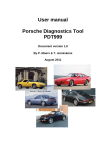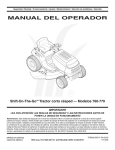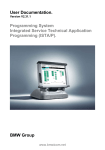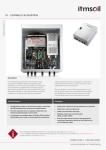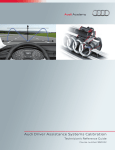Download X-431 Pad Service Manual
Transcript
LAUNCH X-431 Pad Service Manual 12 LSDC 3111 0033 A Confidential:G 2012/10/31 X-431 Pad Service Manual No:12 LSDC 3111 0033 A Written by Checked by Approved by Name Youxing Lee Jinsong Liao Wei Zhang Date 2012-10-31 2012-11-1 2012-11-1 1 LAUNCH X-431 Pad Service Manual 12 LSDC 3111 0033 A Confidential:G 2012/10/31 CONTENT Chapter 1 Basic Knowledge.......................................................................................................4 1.1 Automobile Population .................................................................................................... 4 1.2 Automobile Malfunctions ................................................................................................ 4 1.3 Automobile Detection...................................................................................................... 7 1.4 Automobile Diagnoses..................................................................................................... 8 1.5 Automobile Repairs ......................................................................................................... 8 1.6 Automobile Decoder (Diag. Tester) ................................................................................. 8 Chapter 2 Industry Knowledge ................................................................................................10 2.1 History of Product Development ................................................................................... 10 2.2 Competition Analysis..................................................................................................... 14 2.3 Sales and service modes ................................................................................................ 20 Chapter 3 Product Knowledge .................................................................................................21 3.1 Brief introduction........................................................................................................... 21 3.2 Product history............................................................................................................... 22 3.3 Working Principle of Product ........................................................................................ 23 3.4 Product Configuration ................................................................................................... 23 3.5 Product Function............................................................................................................ 27 3.6 Main Parameters of the Product..................................................................................... 27 3.7 Packing & Transportation .............................................................................................. 28 Chapter 4 Installation and debugging requirements.............................................................29 4.1 Quick Start Guide .......................................................................................................... 29 4.2 Routine maintenance ..................................................................................................... 31 Chapter 5 FAQ ...........................................................................................................................32 5.1 About Hardware............................................................................................................. 32 5.2 About Software .............................................................................................................. 32 5.3 About System................................................................................................................. 33 5.4 Other questions .............................................................................................................. 33 Chapter 6 Service Policy ..........................................................................................................35 6.1 Equipment depot repair.................................................................................................. 35 6.2. Spear Parts Management Regulation............................................................................ 36 6.3. Quality Claim Regulation ............................................................................................. 38 2 LAUNCH X-431 Pad Service Manual 12 LSDC 3111 0033 A Confidential:G 2012/10/31 Revised Record No. Version Amendments Revised by Revision Date A V1.00.000 Complied Youxing Lee 2012-10-31 B C D E F G H I J K L M N O P Q 3 LAUNCH X-431 Pad Service Manual 12 LSDC 3111 0033 A Confidential:G 2012/10/31 Chapter 1 Basic Knowledge 1.1 Automobile Population Till Aug.16th, 2011, the global vehicles which are in use is over 1 billion, among which there are cars, trucks and buses. America has the most vehicles. The registered vehicles are over 240 million. Till the end of August, 2011, China’s vehicle ownership is up to 219 million, among which the motorbike’s percentage is 54.12%, around 119 million. Car ownership is 45.88% of the whole volume, just over 100 million. Japan has 7.4 million vehicles. According to the statistical data, the global car average ownership is 1:6.75, which means that 1 out of 6.75 people owns a car. In America, the ratio is 1:1.3; in France, Japan and Britain, the ratio is 1:1.7; in China, the ratio is 1:17.2. In 2011, the global sale of new light vehicle is 7.65 million, which is 6 percentages higher than that of 2010 and also breaks the 70 million sales record made in 2007. The new emerging markets including China, India and Brazil, will continuously expand on the basis of 51% of the global vehicle ownership. Generally speaking, the emerging markets will take up 53% of the total light vehicle sales in 2011. This indicates that the new emerging markets will be the key factor that stimulates the development of the market. The Asian auto market will continuously maintain good development in future. This area went through more than 25% of the growth in 2010. It’s estimated that in 2011 Asian market will increase 7%-8%, and the sales volume will take up 42% of the global sales. Among which, China’s auto market increase will still be very obvious. The situation of each area: in 2011, the production and sales amount of vehicles in China is 1.84189 and 1.85051 million, which increases 0.84% and 2.45% than same period of last year. Among which, the passenger car sales of the country’s self-own brands is over 6.1122 million, which decreases 2.56% than same period last year. America’s light vehicle sales of 1.16 million outnumbered North American market, which increases 11% than 2009’s sales of 1.04 million. Canada finishes the sales volume of 1.6 million which increases 7% than last year. Brazil takes up 75% of the total sales of South America. Australia reaches the second highest sales volume of yearly sales in 2010. The vehicle renew plan of western European governments was quitted in 2010, which leads the decrease of the sales. It’s estimated that even till 2012, the western European market is still unpleasant. 1.2 Automobile Malfunctions 1.2.1 Definition The components or assembly are partly or completely lost their operating abilities. 4 LAUNCH X-431 Pad Service Manual 12 LSDC 3111 0033 A Confidential:G 2012/10/31 1.2.2 Classifications 1) ¾ ¾ Existing time Intermittent: Appears only in the short time when the problems have been existence. Continuous: Can be troubleshot after components have replaced. 2) Occurred time ¾ Abruptness: Without any sign, coincidence, can not be detected by diagnosis ¾ Gradually: Technical conditions deteriorated by the abrasion, weariness, deformation, corrosion, and ageing, etc. Can be detected by earlier diagnosis. 3) Performance affected ¾ Functional: The automobile can not carry on its functions, e.g. steering failure, wandering drive, etc. ¾ Parameter: The performance parameter can not reach its standard, e.g. engine power declined, fuel consumption increased, emissions exceeded the standard, etc. 4) ¾ ¾ ¾ ¾ Consequences Slightly: Can be expelled by suitable adjustment General: Replace wearing parts or expelled in a short time by using tool box Severe: Main parts were severe damaged. Deadly: Cause vicious incidents. 5) Artificial and Natural 1.2.3 Common Malfunctions For the common fault, they can be determined from the abnormal of vehicle performance and appearance symptoms by experience, sensory and equipment. Common faults are: 1) Abnormal Performance Abnormal performance of the car is because of the poor power and economy, mainly in the significantly lower maximum speed, poor vehicle acceleration performance; consuming large quantities fuel and engine oil. Poor vehicle ride comfort, vehicle vibration and noise increased significantly. Poor vehicle operating stability, goes wandering easily, shimmy the front; braking deviation, braking distance too long or no braking. 2) Abnormal Operation Conditions The abnormal phenomena suddenly occurred during vehicle operating, should be prevented: sudden engine flameout during the driving; can not brake when the car need to; can not start in winter; can not start after engine flameout; steering suddenly failed in driving; what's more, the burst tyre, and car spontaneous combustion and so on. The symptoms are obvious, but have more complicated causes: Mainly because the internal fault was not noticed, and developed into a sudden damage. 3) Abnormal noise The abnormal sound happened during driving, is the car fault "alarm." The car driver should be aware of a problem when heard the sudden abnormal sound, and stop the car immediately and check, must not let the vehicle "ill operating." 5 LAUNCH X-431 Pad Service Manual 12 LSDC 3111 0033 A Confidential:G 2012/10/31 Abnormal noise is the easiest way the trouble to be showed during the operating. It can be heard by the driver and the occupant under normal circumstances. The experienced people can judge the problems by the location of the noise, sound frequency and the timbre: Generally speaking, the heavy sound with strong vibrating associated with more serious failure, the vehicle should be stopped, lower the engine speed or shut down the engine to find the problem; some noises due to some of the parts is faulty, that does not affect the driving, and it can not check out soon, drive the car back to the base or the garage nearby and go for check by the experienced personnel. 4) Unpleasant Smells People are very sensitive to the unpleasant smells, especially in car driving. Determine first to find out whether it's the car or not. The car smell mainly are the burning smell produced by non-metallic friction material on the brake and clutch; the specific odor of battery electrolyte; burning smell from automotive electrical system and wire. Sometimes the sticky burning smell of the leaked engine oil and abnormal gasoline smell can be smelt. They all should be adequately noticed. 5) Overheat The vehicle overheating means each part of the vehicle temperature is beyond the normal automobile temperature range. Engine overheating can be significantly shown on the boring of the radiator; transmission overheating, rear axle overheating and brake overheating can be shown by hand touching or water test. Further examination should be place to discover the deep causes, it does not influence driving due to a long time with high load; if the case of internal organs malfunction, should be timely diagnosis and excluded. 6) Abnormal Exhaust Gas Color Cars in operation, if brake dragging, clutch slipping happened, will emit a burning friction plate smell; engine overheating, lubricating oil goes into the combustion cylinder, it will divergence a special odor; burning smell can be sensed when short circuit and grounding wire. In the course of the engine, the normal combustion products should be the main component of carbon dioxide and a small amount of water vapor. If the engine abnormal combustion, the exhaust will be mixed with incomplete combustion of carbon particulates, hydrocarbons, carbon monoxide and a lot of water vapor. In addition, nitrogen oxides, etc., then the color may be black, blue or white. That color is not the normal exhaust smoke. For gasoline engine, the normal should be no visible exhaust smoke. But the oil goes up to cylinder, it will become blue; incomplete combustion will be black; and when oil mixed with water, the exhaust is white. The gas color that Engine exhausted appears the engine working condition. Exhaust smoke from the engine combustion normally have a certain color, and it changes when the engine is not working properly. Blue exhaust when the engine oil is burning, that means engine needs repairing; for the incomplete engine combustion, the exhaust is black, fuel should be changed or adjust the ignition timing; when engine exhaust is white, say, there is water in the oil or cylinder, the fuel or the engine should be checked. 7) Leakage Leakage is defined as an automobile engine fuel, lubricating oil (or gear oil), brake fluid (or air), and the power steering fluid leakage, etc.. It is also obvious failure symptoms, careful observation can be found. For example, compressed air leaks, you can clearly hear the sound of air leakage. Leakage performance of automotive fuel leaks, oil leaks, coolant leak, brake fluid 6 LAUNCH X-431 Pad Service Manual 12 LSDC 3111 0033 A Confidential:G 2012/10/31 leakage, steering oil leakage, oil leakage and refrigerant leakage, as well as battery fluid leakage of the electrical system and electrical system leakage and so on. Car overheating car easily cause leakage and institutional damage. Prone to leak oil as vehicle steering failure; easily cause brake fluid leakage, etc. brake disorder. 8) Appearance Disorders Car parking space in the flat when, check the appearance of the sometimes find vehicle longitudinal or horizontal skew deviation, showing the appearance of disorders. Check the tire pressure should be noted, frame and suspension damage, body damage and other irregularities. Disorders may affect the appearance of car to car use. Such as cars center of gravity shift, severe vibration, steering instability and cars deviation and so on. 9) Abnormal During Driving Driving different cars can not usually manifested by the will of the driver to speed up and the steering and braking, car control mechanism can be perceived failures and implementing agencies, in addition to the accelerator pedal, brake pedal, clutch pedal and steering wheel and transmission institutions to check and adjust, but also should conduct a comprehensive inspection. Find fault, and normal maintenance then the car can be used. 1.3 Automobile Detection 1.3.1 Definition The use of modern detection techniques and equipment for disintegration vehicle inspection and test, its purpose is to determine the technical condition of vehicles and the ability to work. 1.3.2 Content ¾ Security: including braking, sideslip, steering and headlamp testing. ¾ Reliability: including automobile abnormal noises, wearing, deformation and crack detection. ¾ Dynamics: including speed, acceleration, chassis power output, engine power, torque and ignition system, fuel system status detection. ¾ Economic: including fuel consumption test. ¾ Regulations adaptability: include status of vehicle noise and emissions testing. 1.3.3 Classifications 1) Safety Performance ¾ Content: Only test the safety. ¾ Objective: To ensure that the car has to meet the requirements of the appearance, safety, noise level, emissions targets, to enhance vehicle safety. 2) Comprehensive Performance Test ¾ Content: test car safety, reliability, power, economy and environmental protection, etc. five main performances. 7 LAUNCH X-431 Pad Service Manual 12 LSDC 3111 0033 A Confidential:G 2012/10/31 ¾ Objective: the disintegration of the car is not the case, determine the capacity and technical status of transport vehicles to improve transport efficiency and reduce consumption, make the transport vehicle having good economic and social benefits. 3) Maintenance-related vehicle inspection ¾ Content: Only detect the vehicle safety, environmental protection and the speed in power performance. ¾ Objective: According vehicle inspection, to determine the need for major repairs, to find the exact failure location and cause to improve the quality of maintenance. 1.4 Automobile Diagnoses 1.4.1 Definition By the inspection, analysis, determine the completion of a series activities; it's a test of automotive technology status, aimed at identifying the causes and exact location. 1.4.2 Classifications 1) Diagnosis by experience Mainly depends on the artificial observation, analysis and logic reasoning, often in conjunction with the disintegration of the repair work carried out. Diagnosis of slow, poor accuracy, requiring diagnosed a wealth of practical experience and high technical level. 2) Diagnosis by equipment analyzing Using a variety of testing instruments and equipments for a variety of automotive data and by using the data to determine the technical condition of the car, without disintegration. Diagnosis speed very fast, high accuracy can be quantitatively analyzed with large investment. 1.5 Automobile Repairs Vehicle repairs are car maintenance and car repairs in general. ¾ Auto Maintenance: To maintain the technical condition of vehicle and ability to work for the job. Can extend vehicle's service life, safe and reliable; fulfill its effectiveness. ¾ Auto repair: technical condition for the resumption of vehicle capacity and service life or work carried out the operation. Extend vehicle life; protect the car for continued use. 1.6 Automobile Decoder (Diag. Tester) 1.6.1 Definition Quickly and accurately acquire vehicle engine performance and fault information through the connection and communication with ECU. 8 LAUNCH X-431 Pad Service Manual 12 LSDC 3111 0033 A Confidential:G 2012/10/31 1.6.2 Market Background With the increasing degree of automotive electronics, which inevitable arouses a great changes of car decoder markets. In recent years, with the rapid development of automotive research and manufacturing technology, vehicle electronics becomes more and more popular. Customers drive their cars for more safety, comfort and stability. This brings new requirements for repair. As the basic equipment in the field of automotive repair, the market of scanner has changed a lot. New requirements are demanded for the scanner in the automotive field. The process in science and technology has changed the vehicle from "machine with four wheels" to "computer with four wheels". Most operations are controlled by electronic control technology. Nowadays, the electronic control technology is applied in many systems, such as: ——Powertrain system: Engine system (ESA, EFI, EGR, and ISC, etc.), AT, and Immobilizer, etc. ——Chassis System: ABS, ASC, CCS, and Collision Avoidance System, etc. ——Body system: Cluster system with information display and alarm, Navigation, Communication, Automatic A/C, Automatic Seat, and Audio System, etc. As the operations on vehicle tend to electronic control, the electronic control system diagnosis is playing an important role in the development of an automobile maintenance enterprise. The traditional experience in repairing can not meet the current needs of automobile development. The advanced maintenance equipment is an essential part in repairing. 1.6.3 The birth of LAUNCH diagnostic products LAUNCH, as the pioneer of auto aftermarket, has been at the forefront on the R&D of automotive after-market products in the industry. In 1994, LAUNCH has taken the lead in developing the first generation of domestic automotive diagnostic computer-431ME which owned independent intellectual property rights, which established a precedent in the domestic automotive diagnostic industry and lead China automobile repair industry into a new era. The concept of "electronic eye" come from LAUNCH has now been widely accepted and been consistent use in the industry, which represents the creativity and pilot of LAUNCH company in the industry. After that, company continuously developed a serial of new automotive decoders, also popular on the markets, such as ADC2000, X-431 Super scanner, X-431 TOP, X-431 TOOL, X-431 Diagun etc. With 20 years of automotive diagnostic technology experiences, LAUNCH Tech.Co. Ltd heartfelt produces X-431 PAD integrated intelligent automotive failure diagnostics, which fully represents enterprise and its culture in 2012. This is the first significant diagnostic product after LAUNCH enters into the Telematics. 9 LAUNCH X-431 Pad Service Manual 12 LSDC 3111 0033 A Confidential:G 2012/10/31 Chapter 2 Industry Knowledge 2.1 History of Product Development 2.1.1 Development of the Automobile Electronic Technology 2.1.1.1 Fast Development of the Electronic Technology In the past 10 years, the automotive industry two significant changes occurred. First, the growth point is by European and American markets from Asian countries to developing regions of the market-based transfer. Data show that from 2007 to 2012, Asia and Europe will dominate the global vehicle production 89%, BRICs and other Asian countries will become the main force of automobile consumption. Second, the mature European and American countries in the market, improve the car's performance more dependent on electronic technology. Studies have shown that from 1989 to 2005, electronic equipment manufacturing costs in the proportion of the vehicle, from 16% to 30%. In 2011, each IC's cost about the new car at 360 dollars will be 3% to 4% annual growth rate has continued to grow. Automotive electronics technology development and large-scale applications are from the 20th century began in the late 70s, and 70s from the 20th century to 80 years, roughly experienced three stages of development. The first development stage before 1971 began production technology from a low alternator, voltage regulator, electronic flash, electronic horn, intermittent wiper devices, car radios, electronic ignition and digital clock and so on. The second development stage is 1974 to 1982. Integrated circuits and below16-bit microprocessors' application on the car is the sign. Including electronic fuel injection, automatic door locks, programmable driving, high-speed warning system, automatic lighting system, automatic defrost control, ABS, vehicle orientation, collision warning sensors, electronic timing, electronic transmission, closed-loop emission control, automatic cruise control, security systems, vehicle fault diagnosis and other electronic products. Most representative of this period is the development of electronic fuel injection technology and anti-lock braking (ABS) technology matures, making the car's major mechanical functions to control the use of electronic technology. However, at this stage mechanical and electrical connection is not very satisfactory. The third stage of development from 1982 to 1990, the microcomputer applications in the car becoming more reliable and mature, to the intelligent direction. Tire pressure control of the development of products, digital oil pressure meter, anti-sleep device, traction control, all-wheel steering control, look into the instrument panel, voice synthesis and recognition, electronic load regulator, electronic road monitors, cellular phones can be heated windshield, reverse warning, speed limiter, automatic rearview mirror systems, road condition indicators, electronic cooling control and the parasitic power control. Since 2005, it can be said to enter the automotive electronic technology the fourth stage of development. Microwave systems, multi-channel transmission system, ASKS-32-bit microprocessor, and digital signal processing applications, so that communication and coordination-oriented system, automatic anti-collision system, dynamic optimization system, autopilot and electronic mapping technology have been developed, particularly is the emergence 10 LAUNCH X-431 Pad Service Manual 12 LSDC 3111 0033 A Confidential:G 2012/10/31 of intelligent vehicles. 2.1.1.2 Electronic Technology Requirement for Automotive Industry ¾ ¾ ¾ ¾ ¾ Power Economy Safety Comfortable Environment Protection 2.1.1.3 The Applying Of the Automobile Electronic Technology ¾ ¾ ¾ ¾ Engine management system Automobile trouble self diagnosis Identification technology based on figure Automobile network communication technology: CAN/FlexRay/MOST 2.1.2 Automobile Network Communication Technology 2.1.2.1 The rapid development of automotive harness To improve the performance of the introduction of a large number of car electronics systems, leading to the rapid increase in wiring harness, and a significant increase in the wiring harness has hindered the further improvement of vehicle performance. Therefore, we must find a new technology and reasonable solution to the problem. Twentieth century, the early eighties there car network communication technology, is the best way to resolve this contradiction. Below: Figure 1 Trends for the Harness Number of the Volvo 2.1.2.2 Typical Network for Modern Automobile 11 LAUNCH X-431 Pad Service Manual 12 LSDC 3111 0033 A Confidential:G 2012/10/31 Figure 2 Typical Network Diagram for Modern Automobile 2.1.2.3 Classifications for the automobile network It can be divided into the following five categories by functions and velocity: 1) A class: low-speed network for the actuators, sensors ¾ A major class network for sensors, actuators, control. ¾ Bitrates is generally 1 ~ 10Kbps, main types of network protocols: LIN, UART, CCD, etc. ¾ Suitable for less demanding real-time occasions, mainly used in body control, such as electric windows, central locking, mirrors, seat adjustment, lighting, vehicle fault diagnosis of early 2) B class: data sharing between modules for medium-speed network ¾ B class network protocol mainly for data sharing between separate modules, suitable for real-time less demanding situations, in order to reduce redundant electronic components. ¾ Bitrates is generally 10 ~ 125Kbps, main types of network protocols: ISO11898-3 (fault-tolerant CAN), J2248, VAN (Vehicle Area Network), J1850 (OBD2), etc. ¾ Mainly used in electronic vehicle information center, fault diagnosis, instrument display in the control ¾ With the automotive network technologies, current and future mainstream B-class network protocol will be: CAN (ISO11898-3) 3) C Class: Multi-oriented, real-time closed-loop high-speed network ¾ Mainly for high-speed, real-time closed-loop control of multiple control multiplexing network ¾ Bit rates up to 10Mbps or more, the main types of network protocols: ISO11898-2 12 LAUNCH X-431 Pad Service Manual 12 LSDC 3111 0033 A Confidential:G 2012/10/31 (high-speed CAN), TTP (Time-Triggered Protocol) / C, FlexRay, etc. ¾ Mainly used in power systems, real-time control and high reliability requirements of the occasion ¾ Currently, C class networks are¬ widely used in power and transmission system control and communication protocol standards: ISO11898-2, the next applied to X-By-Wire system, the main agreements: TTP / C and FlexRay 4) D class: for information, the network multimedia systems ¾ D class of intelligent data bus networks collectively referred to as IDB (Intelligent Data Bus), mainly for information, multimedia systems, etc. ¾ According to SAE Category: IDB-C (low): SAEJ2366; IDB-M (high speed): D2B, MOST, IDB1394 etc.; IDB-Wireless (Wireless Communications): Bluetooth, etc. ¾ D class of network protocols, the bit rate at 250Kbps ~ 400Mbps between 5) E Class: occupant safety systems for ¾ E class networks mainly for occupant safety systems used in the field of passive safety of vehicles ¾ Bit rate is usually in 20K ~ 10Mbps, network protocol types are: SafetyBus, Planet, Byteflight etc. 2.1.3 Development of the Automobile Decoder Automotive detection technology develops with automotive industry. In the early stage of automotive development, specified detection upon a wealth of practical experience. That is, depends on the artificial observation, analysis and logic reasoning. Along with the process of modern science technology, especially computer technology, automotive detection technology rapid develops. Nowadays, people rely on a various advanced equipment to test vehicle without disintegration. More important, it is safe, rapid, and reliable. In shortly, automotive decoders, is a special equipment, which upon the connection between the PC data output and DLC with purpose of data exchange in various ECU. Decoder is divided into original and non-original decoder. The original automotive decoder is provided or designated by automotive manufactories, such as Benz STAR2000, BMW GTI, Volkswagen (Audi) VAS5052, TOYOTA INTELLIGENT TESTER, Nissan CONSULT 1/11, etc. General speaking, each automotive manufacturer has the original code detector of all kinds products which would be able to provide better aftermarket detection services. However, the non-original decoder is not provided and designated by the automotive manufacturer, instead of other equipment supplier. Such as KTS300/500 from Bosch (German), Scanner MT2500 of Red Brick from Snap On (USA), OTC from SPX Corp. Ltd, CARMAN from Korea, LAUNCH (Shenzhen), Beijin JBT, Shenzhen FCAR from domestic (China). The development of automotive Decoder group into the following FIVE stages: ¾ LED Code: It was the earlier automotive detection solution. Connection with LED was between ground and signal cable. Base on the frequency and time duration of lighting, and refer to LED CODE TABLE, would be able to diagnose the automotive fault position and reason. ¾ Code Reader: It was the earlier automotive code reader to read the fault code in ECU. Refer to FAULT CODE TABLE to identify the automotive fault position and reason. ¾ Detection Device (Class A Network): Earlier general diagnoses device, with code reader, 13 LAUNCH X-431 Pad Service Manual 12 LSDC 3111 0033 A Confidential:G 2012/10/31 clearer, data steam in part system and easy motion testing function, but no CAN BUS function. ¾ Original Decoder (Class A&B Network): Original fault diagnostic device, with fault diagnoses function for signal brand of automotive manufacturer, mainly produce for custom-made servicer factories and 4S stores. Intelligent Decoder (Compatible for Class A,B,C,D,E Network): Most common diagnostic device, similar to X-431, X-431 Diagun, X-431 PAD from LAUNCH. 2.2 Competition Analysis 2.2.1 Overseas Competition Analysis 14 LAUNCH X-431 Pad Service Manual 12 LSDC 3111 0033 A Confidential:G 15 2012/10/31 LAUNCH X-431 Pad Service Manual 12 LSDC 3111 0033 A Confidential:G 16 2012/10/31 LAUNCH X-431 Pad Service Manual 12 LSDC 3111 0033 A Confidential:G 2.2.2 Domestic Competitors Analysis 17 2012/10/31 LAUNCH X-431 Pad Service Manual 12 LSDC 3111 0033 A Confidential:G 18 2012/10/31 LAUNCH X-431 Pad Service Manual 12 LSDC 3111 0033 A Confidential:G 2.2.3 Product Competition Analysis 19 2012/10/31 LAUNCH X-431 Pad Service Manual 12 LSDC 3111 0033 A Confidential:G 2012/10/31 2.3 Sales and service modes ¾ The sales modes applied in the industry are distribution and direct sales, and the service mode is that the distributor or the manufacturer serviceman arranges one to one actual training. ¾ About the equipment maintenance, it shall be carried out by the manufacturer for domestic. And be carried out by the distributors for overseas, the related personnel to the headquarters of the training required. 20 LAUNCH X-431 Pad Service Manual 12 LSDC 3111 0033 A Confidential:G 2012/10/31 Chapter 3 Product Knowledge 3.1 Brief introduction X-431 PAD is the new generation tablet diagnostic scanner of LAUNCH for DBS (Diagnosis Based Solution) car system, configured with Windows Embedded Standard 7 OS, built-in printer and DBScar connector, with wireless (Wi-Fi) and Wired Network, One-click update and vehicle diagnostic functions (via Bluetooth communication). Extended functions: VGA/HDMI projection, Oscilloscope, Engine ignition analysis, Sensor simulation and test, Multimeter, Battery test, and Borescope. Color touch screen, Easy operation. Figure 3 Appearance of X-431 PAD main unit 21 LAUNCH X-431 Pad Service Manual 12 LSDC 3111 0033 A 3.2 Product history 22 Confidential:G 2012/10/31 LAUNCH X-431 Pad Service Manual 12 LSDC 3111 0033 A Confidential:G 2012/10/31 3.3 Working Principle of Product Figure 4 X-431 PAD Working Principle Diagram 3.4 Product Configuration 3.4.1 Introduction of X-431 PAD Complete Unit Figure 5 X-431 PAD Frontal Structure Diagram 23 LAUNCH X-431 Pad Service Manual 12 LSDC 3111 0033 A Confidential:G 2012/10/31 Figure 6 X-431 PAD Behind Structure Diagram No. Name Descriptions 1 Communication indicator It flashes while X-431 PAD communicates with DBScar diagnostic connector. 2 3 Bluetooth indicator It lights up while Bluetooth is activated. Power indicator It lights up while X-431 PAD is on or in use. 4 DBScar diagnostic connector To communicate with X-431 PAD main unit. 5 Slot for DBScar diagnostic connector Only for housing DBScar diagnostic connector 6 Stylus For clicking operation USB port To connect USB devices. While extending X-431 PAD function, it is to be connected to Scopebox, Sensorbox or batterybox. VGA port To connect an external projector or monitor etc 7 8 24 LAUNCH X-431 Pad Service Manual 12 LSDC 3111 0033 A Confidential:G 2012/10/31 9 Ethernet port To connect Ethernet cable for wired network 10 HDMI port To connect an external projector or monitor with HDMI interface 11 12 Borescope interface To connect an Borescope Power interface To connect the included power adaptor 13 Touch screen Color touch screen for displaying. On-screen keyboard and handwriting input are supported. 14 15 16 Charging slot Place X-431 PAD on the charging base (optional) for charing. Power button Press once to turn it on; keep it pressed for while to turn it off. Camera/video button for photographing or video recording 17 Screen button To capture the current screen 18 19 20 SD card slot To store SD card Audio out port Audio in port Cover for DBScar diagnostic connector holder Printer Camera lens Buzzer & air vent Air intake vent Battery cover Hook/stand To connect earphone To connect audio device, such as amplifier. Remove the cover and connect the DBScar diagnostic connector to the DLC simulator for user experience or demonstration. To print the result out To take photos or record video To exhaust heat to ensure a normal temperature. 21 22 23 24 25 26 capture 27 7400mAh lithium polymer battery is installed below it. Use fingers to lift the hook up, then hang it on the target object; To place it on a desk, unfold the hook as an stand to support X-431 PAD. 3.4.2 Configuration Accessories Accessories in X-431 PAD are adaptable, but configuration would be different according to different markets, including diagnostic software, testing port. Details refer to local agent or random distribution from X-431 PAD configuration packing list. No. ERP Number 1 Name X-431 PAD main unit Qt. Descriptions To connect X-431 PAD main unit to DBScar diagnostic connector 1 25 Pictures LAUNCH X-431 Pad Service Manual 12 LSDC 3111 0033 A DBScar diagnostic connector 2 DBScar cable 3 1 To connect vehicle’s DLC. 1 To connect X-431 PAD and DBScar connector 1 To obtain power supply from vehicle’ s cigarette lighter 1 To convert 100~240V AC power supply to 12V DC power supply. 1 For clicking or writing on the screen 1 For memory USB Cigarette cable 4 Power adaptor 5 Stylus 6 Confidential:G 2012/10/31 to SD card (optional) 7 OBD II extension cable 8 199010001 9 Thermal printing paper extending Extension cable for port and diagnosis socket Information printer 1 1 3.4.3 Standard Configuration Hardware in this product only supports fault diagnostic for the cars, and unity for the following two configurations: 1. 301180018 X-431 PAD OVERSEA Configuration, open for whole oversea regional market. 2. 301180003 X-431 PAD PROFESSIONAL Diagnostic Configuration, only for Chinese regional. 26 LAUNCH X-431 Pad Service Manual 12 LSDC 3111 0033 A Confidential:G 2012/10/31 3.5 Product Function a) b) c) d) e) f) g) h) i) j) Compact Structure, Strong Hardware Configuration: 1.6GHz Dual-core CPU processor, 9.7 inch HD IPS screen, built-in thermal printer, and diversification interface, to meet customers personalized needs. Rich Multimedia Device: integrated with camera, video, and projection output. Unique Screen with 12 set Data Flow Waveform Display: Display multiple (MAX 12) groups data flow waveform figure clearly in a screen , which would be convenience for failure fast analysis and judgment. Custom- made Remote Collaboration Function Combining with modern communication technology, as the first high-end diagnosis product in DBScar application from LAUNCH Corp. Ltd: completely adaptable to mainstream communication mode, such as WiFi, Bluetooth, 3G., and satisfy 2-3 years relevant commercial products inspection. Diversity Internet Application: Provide online update, feedback and query. Simultaneous, supply full open browser, and switch access LAUNCH www.dbscar.com directly. Similarly AllData (USA) and AutoData (Euro) professional website supply relevant data and information queries conveniently to solve work working questions and services support. A few website would require charging for database services. ONE KEY which is variation, convenient, efficient: Provide multiple functions, such as ONE KEY Screen Capture, ONE KEY Upgrade, ONE KEY Feedback, ONE KEY Switch, and ONE KEY Recovery, to solve general operation questions in system, which lead to greatly improve work efficiency. Flexible and Convenient Operation: Supply different operation, as desktop placing, steering wheel setting, handheld and suspension hood use mode. Extensive Models Coverage: inherited all functions in X-431 series products function, which is the most widely coverage of comprehensive diagnosis products, It covers 220 different automotive modes, over 90% automotive market in Asia, Euro, the United States, and 2500 different diagnosis software. Special Features: Accompany with 20 years diagnostic technology experience, continuous development base on basic diagnosis functions, would extend many special features covering different forms of products. Main functions: ¾ Read ECU information ¾ Read DTCs ¾ Clear DTCs ¾ Actuation test ¾ System basic setting ¾ Read data-stream ¾ Read independent channel data ¾ Match channel ¾ Control unit coding ¾ Terminate test communication ¾ System log in 3.6 Main Parameters of the Product ¾ 1.6GHz Dual Core Processor 27 LAUNCH ¾ ¾ ¾ ¾ ¾ ¾ ¾ X-431 Pad Service Manual 12 LSDC 3111 0033 A Confidential:G 2012/10/31 Memory --- 2GB. Hard Disk --- 16GB SSD Battery --- 7400mAh, 7 hrs 9.7’’ TFT IPS Wide Screen 1.3 million pixels (640 x480 resolution) camera High speed thermal printer VGA&HDMI 3.7 Packing & Transportation The packing box of X-431 PAD is made of PVC, which is not inflammable and high resistance against force and chemical corrosive. It can provide strong protection for the product. This material is not easily flammable, high strength, resistance to climate variability and excellent geometric stability, oxidants, reducing agents and strong acids have a strong resistance. 3.7.1 Packing Use of carton box for packing: Packing Size: L600mm×W170mm×H415mm Net Weight: 9Kg Gross Weight: 10Kg 3.7.2 Transportation The following transportation package size and weight data for reference, check the invoice for the specific configuration of the transport packaging Packing Size for Export (six boxes in one carton) Size: L1056mm×W618mm×H440mm Net Weight 为: 60Kg Gross Weight:: 62Kg Packing Size for Export (container in size of 20") Size: L5890mm×W2350mm×H2390mm Full load in 6 container, 111 cartons or 666 units 28 LAUNCH X-431 Pad Service Manual 12 LSDC 3111 0033 A Confidential:G 2012/10/31 Chapter 4 Installation and debugging requirements 4.1 Quick Start Guide 29 LAUNCH X-431 Pad Service Manual 12 LSDC 3111 0033 A 30 Confidential:G 2012/10/31 LAUNCH X-431 Pad Service Manual 12 LSDC 3111 0033 A Confidential:G 2012/10/31 Notice: 1) Only test for under 14.2V Petrolic vehicle 2) Test voltage whether in measurable range or not when Diagnosis socket (self powered) is no power. 3) Do not plug diagnosis port when device in diagnostic communications. 4) Please refer to the Device Information Manual to get proper operation. 5) Working under oscillographic module without electromagnetic interference conditions. Please refer to X-431 PAD Product Specification for detailed registration, software download upgrade, device operation, installation and commission. 4.2 Routine maintenance In daily use, the surface of touch screen shall be kept clean, which can be wiped with the cleanser or the wet cloth. The touch screen may drift while using, i.e. the touch is not accurate, which can be calibrated via the touch screen calibration procedure. 31 LAUNCH X-431 Pad Service Manual 12 LSDC 3111 0033 A Confidential:G 2012/10/31 Chapter 5 FAQ In process of operation of X-431 PAD, you may come across some questions, including the software, hardware, operation and something related to the vehicles. Read the user’s manual to get the answer if you have any question. If it can not be solved still, please note it down and contact our Customer Service Center (hotline: +86-0755-84528767) for help. Here, we list some frequently asked questions and answers on using X-431 PAD. 5.1 About Hardware 1Q: Why does the LCD touch screen respond so slowly in cold whether? A: It is because the ambient temperature is close to the lower limit of operating temperature range (-10-55℃). Under this situation, it is necessary to warm up the machine for 30 minutes before test. 2Q: There is only backlight and no character on the screen. What should I do? A: Check if the power is well connected. Turn off the machine, unplug the power connector and re-plug it. Turn on the machine after it has been connected to the power for 1 second. 3Q: Why there is no response or response incorrectly while clicking the screen with touch pen? A: Please calibrate the screen again. 4Q: What can I do when the screen is confused? A: Please quit the current application (interface), and run it again. If the problem still exists, please restart the system. 5Q: Why can’t the data be input after Soft Keyboard is activated? A: The position where the cursor locates can’t be edited. Or you have not activated the cursor in the input position, please use the stylus to click the part to edit. You can input the data if the cursor flashes. 6Q: Why X-431Diagun fails in communication with ECU? A: Please check and make sure that the diagnostic connector and diagnostic program are matching the vehicle make. 5.2 About Software 1Q: System halts when reading data stream. What is the reason? A: It may be caused by a slackened connector. Please turn off the machine, firmly connect the connector, and switch on the machine again. 2Q: Why X-431 PAD fails in communication with ECU? A: ECU does not respond. Please try to use the latest update tool to upgrade to the latest diagnostic program. 32 LAUNCH X-431 Pad Service Manual 12 LSDC 3111 0033 A Confidential:G 2012/10/31 5.3 About System 1Q: Main screen blinks at the moment when engine ignition. A: It results from electromagnetic interference and this is normal phenomena. 2Q: Diagnose interrupted during diagnosing process. A: Caused by electromagnetic disturbing or poor connecting. 3Q: There is no response when communicating with on-board computer. A: Please confirm the proper voltage of power supply and check if the throttle has been closed, the transmission is in the neutral position, and the water is in proper temperature. 4Q: The systems equipped with the vehicle can not be diagnosed. A: DLC of some early models is separated; refer to User’s Manual for details. 5Q: The fault code storage is blank. A: Usually, it’s the “suquela” for shared circuit. Please locate and analyze the most similar fault code and its circuit. 5.4 Other questions 1Q: The thermal paper can no be fed after being loaded. A: It is possible to install it improperly. Refer to Chapter 2.3 Printer in the User’s Manual or consult from our branch offices or dealers. 2Q: How long is the standby time of battery? A: Recharge it correctly. In general, the charging time is about 6 hours for new machine. Once the charing icon disappears, it indicates it is fully charged. If standby time is set, it can last for about 5 hours. 3Q: The screen is too white and characters cannot be seen. What is the reason and what should I do? A: It may be caused by improper contrast. Please refer to the section “Adjust Brightness” to adjust the contrast. 4Q: Why is the machine automatically powered off during standby? A: It is because the machine has been set for energy saving. Automatic shutdown will take place if the machine is not operated for a specified period of time. Refer to the section “Power option” under System setting in User’s Manual. 5Q: Why can’t the tested result be printed out? A: There may be no paper in the printer. Please mount a roll of new paper. See Chapter 2.3 33 LAUNCH X-431 Pad Service Manual 12 LSDC 3111 0033 A Confidential:G 2012/10/31 Printer in the User’s Manual. 6Q: Why is there no character on the printing paper? A: The paper is mounted reversely. Please take out the paper and mount it again. See Chapter 2.3 Printer in the User’s Manual. 34 LAUNCH X-431 Pad Service Manual 12 LSDC 3111 0033 A Confidential:G 2012/10/31 Chapter 6 Service Policy 6.1 Equipment depot repair 6.1.1 Equipment return to factory regulation 1. Equipments can be repaired mean the products of LAUNCH Company 2. Equipments can not be repaired a) Repair without permission of LAUNCH company b) Change the original configuration of LAUNCH company’s products (eg. Serial number, language, etc.) c) Dismounting and assembly without permission d) Decipher LAUNCH software without permission 3. After the preliminary determination to faults by the local service personnel, decide return to factory to repair and notify after-sale service department, the after-sale service department can do second judgment. 4. Branch company and customer back to headquarter to repair, the manufacturer quote the price to the branch company, the branch company quote to the customer, the manufacturer can not quote the price to customers. 5. Repair cycle: 4 working days from the day the repair enterprises receive the depot equipment. Manufacturer’s repair department receive the products, general faults’ repair time is no longer than 4 working days. Special faults’ repair time is no longer than 5 working days. 6. After the products are well repaired, manufacturer need to send products to sale enterprises or customers on the day when branch company ensure the capital arrives (no later than the second day). 7. No spare parts inventory’s old version equipment, apply old change new policy, equipments no longer in production and without spare parts repair, can buy same series products with a lower price. 6.1.2. Repair Charge a) No charges within the warranty period b) The logistics cost of the products within the warranty period is payable by the manufacturer. c) Same fault appears twice in half a year, the logistics cost is payable by the manufacturer. d) Chargeable repairing products, the charge standard is made by the repair enterprises, Repair enterprises notify customers or branch companies. Customers decide whether return the products or disposal regarding to non agreeable products. e) Branch company count the last season’s back to factory accumulated fees on the first month of every season 35 LAUNCH X-431 Pad Service Manual 12 LSDC 3111 0033 A Confidential:G 2012/10/31 6.1.3. Overseas Depot Repair a) When the on-site service can not solve customers’ problems, customer can ask for depot repair. First, distributors are in charge of repair, if the repair can not be done, then distributor can ask branch company or office for help. If the problems can still not be solved, the branch company can ask help from the manufacturer. Since the journey is very long and customs procedures are very complicated, in general, depot repair is not considered; local repair is preferred. b) Product department need to train overseas branch company the “Product Repair Manual”. Overseas branch companies need to train its distributors repair methods and policies. In order to make the repair convenient and quick, overseas branch companies can ask for some common drawings for reference. Core drawings are not allowed to apply for. At the mean time, overseas branch companies need to prepare some repair materials. c) In general, overseas branch companies would not give the distributors or customers the depot repair service due to customs check, clearance cost and cycle reasons. If the distributors and customers send the problem products to the manufacturer to repair, manufacturer doesn’t pay the logistics cost and only provide free repair and free spare parts change for the problem products within the warranty period. 6.1.4. Warranty Period Regulation 1. The warranty period is one year and is counted from the day when the purchase receipt is issued. The warranty period of the product that can not provide the receipt is one year but is counted from the day of the product’s registration or counted from the day two months after the product leave the factory. The earlier date shall prevail. 2. The warranty period of the products that already been repaired or out of warranty period is half a year. 6.1.5. Repair Outfit Regulation 1. According to the market requirement, manufacturer shall provide a new product repair outfit to the branch companies. 2. New products’ repair outfit should be applied by branch companies ; made and sent by the manufacturer. 6.2. Spear Parts Management Regulation 6.2.1 Spear Parts Coding Regulation 1. Manufacturer need to provide branch companies the name of spear parts, exploded view, material codes, amount for a piece, material switching time and settlement price. 36 LAUNCH X-431 Pad Service Manual 12 LSDC 3111 0033 A Confidential:G 2012/10/31 2. Manufacturer code the new and switched materials, need to be updated in time. 3. Branch companies as per the spear parts list, exploded view made by manufacturer quickly check the spear parts codes. 6.2.2 Spear Parts Allocation Regulation 1. In principle, spear parts are allocated twice a month, to the ones that can not be predicted( not often used or no inventory), a CRM on-site service list is directly generated to apply for spear parts allocation. 2. No signal piece allocation or allocation cost lower than logistics cost is allowed unless it’s special occasion. 3. The approval of spear parts allocation need to be finished in one day, at the latest, need to be sent out the next day. 4. The logistics fee for allocation should be paid by the manufacturer. 5. Manufacturer can provide certain amount of free spear parts to distributors according to their sales volume. 6.2.3 Spare Parts Claim Regulation 1. Claim confirmation is performed by the service staff of the branch companies. Have to form detailed “A- market/123 GN product quality claim” or “A-market/124 product quality problem” and directly make “claim application sheet” on the ERP system. Manufacturer is in charge of the warranty control and goods delivery. 2. The returned old pieces can be stored in the branch companies or offices. Branch companies sort out claim list according to on-site service sheet each month. 3. The logistics cost of the claimed spare parts is payable by the manufacturer. 4. The spare parts asked from the supplier should all come back to manufacturer, logistics cost should be payable by the supplier. 5. The price volume lower than 30 Yuan is no need to return old pieces, branch companies can cancel after verification. 6.2.4 Spear Parts Inventory Regulation 1. Inventory spear parts contain fragile and consumable parts and main spear parts. 2. The free allocated spear parts only indicate fragile and consumable parts of lifting machine. Branch companies place the gift purchasing order to the manufacturer. The price is 0, manufacturer makes gift sales order and sends goods leave warehouse. 37 LAUNCH X-431 Pad Service Manual 12 LSDC 3111 0033 A Confidential:G 2012/10/31 3. The free allocated spear parts are governed by 0.2% of the last year’s sales volume. Branch companies can make the detailed spare parts that’s needed within the regulated amount. Manufacturer will directly send to branch companies. 4. The main spare parts inventory is used for timely turnover of customers’ claim. Each area can prepare a suitable amount of spare parts and timely write off according to their monthly turnover. 6.2.5 Overseas Spear Parts Management 1. Manufacturer need to prepare some free spare parts to serve for overseas branch companies. Quota is 1% of the sales volume. Overseas branches can only purchase spare parts not finished products. Quota can be accumulated. If the purchase amount exceeds quota, overseas branches need to pay manufacturers for the exceeded parts. 2. Overseas branches need to establish its spare parts safety inventory. Overseas branches place spare parts purchase order to overseas sales assistant first day of every month. Overseas sales assistants place official purchase order to manufacturer on the ERP system. Overseas sales assistants need to follow the execution of the order. 3. Overseas branches need to constantly understand distributors’ spare parts inventory, If the spare parts is not enough, overseas branches need to push the distributor to purchase the spare parts and supplement spare parts inventory. Improve customer’s efficiency and satisfaction. 4. Overseas branches need to obey the material codes on the“product installation, adjustment and spare parts manual” to purchase the spare parts. If the spare parts are changed, we need to timely understand the ECN released by the product department and check the spare parts codes through IO system so as to avoid misorder the spare parts. 5. If the spare parts change is within the warranty period, the service department of the sales units needs to ask manufacturer for claim. The procedure is in the spare parts claim procedure. 6.3. Quality Claim Regulation 1. The service manager and engineer directly generate product quality claim report on the CRM system if it belongs to one of the following situations: a) Fault appears within one month after the purchase date. b) Many repair appears for one product within half a year. c) Lack spare parts after the new product is received, or new product has defects due to manufacture. d) If the product function can’t satisfy customers’requiements due to products’ design. 2. Service specialist of the head quarter is in charge of the supervision of the execution process of the claim report. 3. The quality department of the head quarter is in charge of the execution of the claim report, submit emergency solution, adjust precaution measures and reply customers. 38 LAUNCH X-431 Pad Service Manual 12 LSDC 3111 0033 A Confidential:G 2012/10/31 4. Service staff of the branch companies has the right to decide whether shut down the claim sheet according to treatment result and the satisfaction degree of the adjustment of precaution measures. 5. All the quality claims need to be replied within 3 hours. 6. Manufacturer should bare the after sale service fee and compensation fee due to severe quality problems. 7. Manufacturer needs to bare the cost of batch call-back due to product quality problems and change products. See”12 HOM 1301 0611A customer claim management regulation 39







































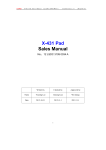
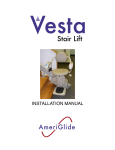

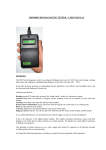
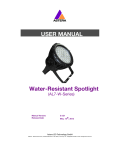
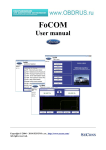

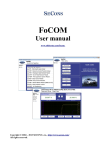

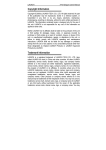
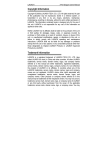
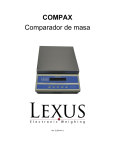
![3 Janela do ESI[tronic]](http://vs1.manualzilla.com/store/data/006056768_1-d0b5f68eb94df67d86abc425e279ce6e-150x150.png)

